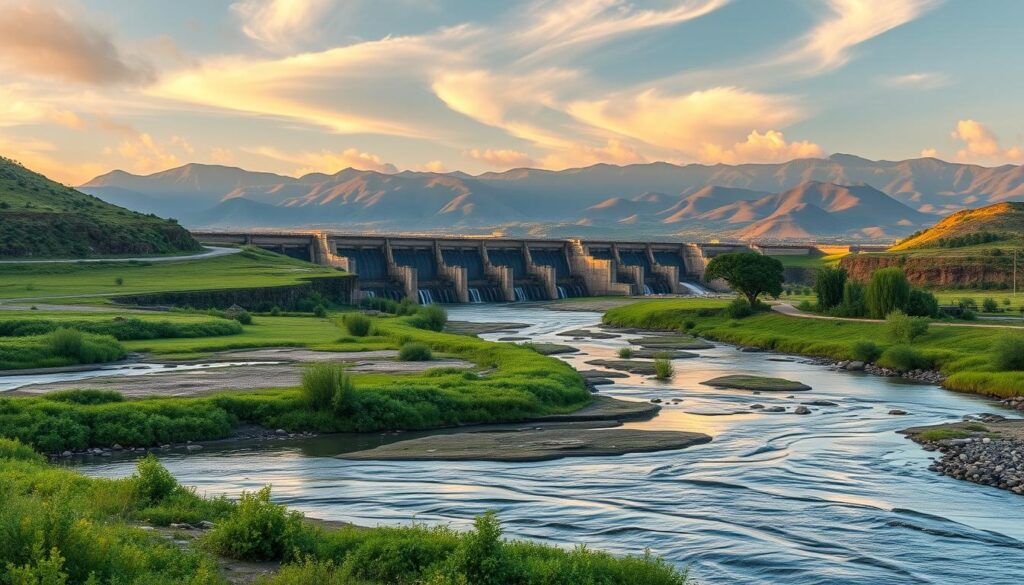Did you know that nearly 1.2 billion people worldwide lack access to clean water? This staggering statistic highlights the critical need for effective water resources management. As research evolves, our understanding of the water cycle is becoming more nuanced, incorporating human activities into models for a more comprehensive view.
The traditional view of the water cycle is giving way to a more dynamic understanding, thanks to advancements in hydrological engineering. By embracing this new perspective, we can better manage water resources, ensuring a more sustainable future. For insights into managing complex projects like those in water resource development, such as dams and water treatment plants, visit our guide on managing civil engineering.
Key Takeaways
- Effective water resources management is crucial for global access to clean water.
- Advancements in hydrological engineering are improving our understanding of the water cycle.
- Incorporating human activities into water cycle models enhances their accuracy.
- Better water management practices lead to a more sustainable future.
- Complex water resource projects require careful planning and management.
What is Hydrological Engineering?
Hydrological engineering encompasses the principles of hydrology and applies them to solve real-world problems related to water. It involves understanding the hydrological cycle and how human activities impact it.
Dr. Yadu Pokhrel’s work, for instance, focuses on how human interventions affect the hydrological cycle, highlighting the importance of hydrological engineering in managing these impacts. According to Dr. Pokhrel, as cited by Kaleigh Harrison, understanding these dynamics is crucial for sustainable water resource management.
“The study of hydrological engineering is essential for addressing the challenges posed by water scarcity and flooding.”
Definition and Importance
Hydrological engineering is defined as the application of hydrologic principles to manage and mitigate the effects of flooding, drought, and other water-related issues. Its importance lies in its ability to help communities and governments make informed decisions about water resources.
The field is crucial for designing and implementing effective water management systems, including those that involve watershed modeling and hydrologic modeling. These models help predict water flow, quality, and availability, enabling better planning and decision-making.
| Aspect | Description | Importance |
|---|---|---|
| Watershed Modeling | Simulates the hydrological processes within a watershed | Helps in predicting water flow and quality |
| Hydrologic Modeling | Analyzes the movement, distribution, and quality of water | Essential for flood control and water resource management |
Key Principles of Hydrology
The key principles of hydrology include understanding the hydrological cycle, which encompasses evaporation, condensation, precipitation, and runoff. Hydrological engineers must consider these principles when designing water management systems.
For those interested in pursuing a career in this field, programs such as the one at Virginia Military Institute offer comprehensive education in hydrology and water resources engineering.
By applying these principles, hydrological engineers can develop solutions to complex water-related problems, ensuring sustainable use of water resources for future generations.
The Role of Hydrological Engineers
As experts in water management, hydrological engineers contribute significantly to infrastructure development and environmental conservation. Their work encompasses a broad range of activities, from designing hydraulic structures to restoring rivers and wetlands.
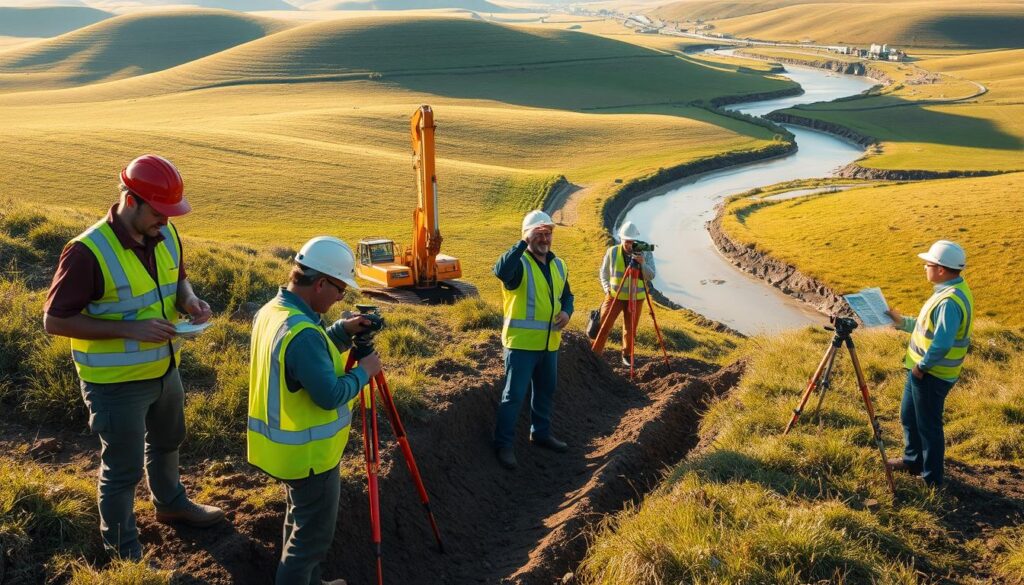
Career Opportunities in the Field
Hydrological engineers can pursue various career paths, including roles in government agencies, private consulting firms, and research institutions. According to Kaleigh Harrison, “Advances in water modeling are proving invaluable for businesses, policymakers, and resource managers,” highlighting the growing demand for skilled hydrological engineers.
- Designing and implementing water management systems
- Conducting environmental impact assessments
- Developing flood control measures
- Restoring rivers and wetlands
Essential Skills and Qualifications
To succeed in this field, hydrological engineers must possess a strong foundation in hydrology, mathematics, and engineering principles. They should also have excellent analytical and problem-solving skills.
| Skill | Description | Importance Level |
|---|---|---|
| Hydrological modeling | Ability to simulate and predict water flow and quality | High |
| Data analysis | Skill in analyzing large datasets to inform water management decisions | High |
| Communication | Ability to effectively communicate findings and recommendations to stakeholders | Medium |
Impact on Infrastructure Development
Hydrological engineers play a crucial role in the design and development of hydraulic structures, such as dams, levees, and canals. Their expertise ensures that these structures are safe, efficient, and environmentally sustainable.
“The work of hydrological engineers is critical in ensuring that our water infrastructure is resilient and adaptable to changing environmental conditions.”
By combining their knowledge of hydrology and engineering principles, hydrological engineers can develop innovative solutions to complex water management challenges, ultimately contributing to more sustainable and resilient infrastructure.
Key Components of the Hydrological Cycle
Effective hydrological engineering requires a deep understanding of the hydrological cycle’s key components. The hydrological cycle, also known as the water cycle, is the continuous process by which water is circulated between the Earth and the atmosphere. It involves several critical processes that are essential for sustaining life on our planet.
Evaporation and Transpiration
Evaporation and transpiration are two primary mechanisms through which water is transferred from the land to the atmosphere. Evaporation occurs when the temperature and humidity levels allow water to change from its liquid state to a vapor. This process is significant in oceans, rivers, and lakes. On the other hand, transpiration refers to the process by which plants release water vapor into the atmosphere through their leaves. Together, evaporation and transpiration contribute significantly to the atmospheric moisture that eventually leads to precipitation.
Precipitation and Runoff
Precipitation is the process by which water vapor in the atmosphere condenses and falls to the Earth’s surface as rain, snow, sleet, or hail. Once the precipitation reaches the ground, it either infiltrates the soil or becomes runoff. Runoff is the water that flows over the land’s surface and into streams, rivers, and lakes. Effective stormwater management is crucial to prevent flooding and erosion control measures are necessary to maintain soil quality and prevent land degradation.
Groundwater Recharge
A significant portion of precipitation infiltrates the soil and becomes part of the groundwater. This process is known as groundwater recharge. Studies, such as those by Mohammed Al Rayaan using satellite technology to map groundwater potential zones, highlight the importance of understanding groundwater dynamics. Groundwater recharge is vital for maintaining healthy aquifers, which serve as crucial sources of freshwater for drinking, irrigation, and industrial uses.
Tools and Technologies in Hydrological Engineering
Advances in hydrological engineering are largely attributed to the development and application of innovative tools and technologies. These advancements have significantly enhanced the ability to understand, predict, and manage water resources.
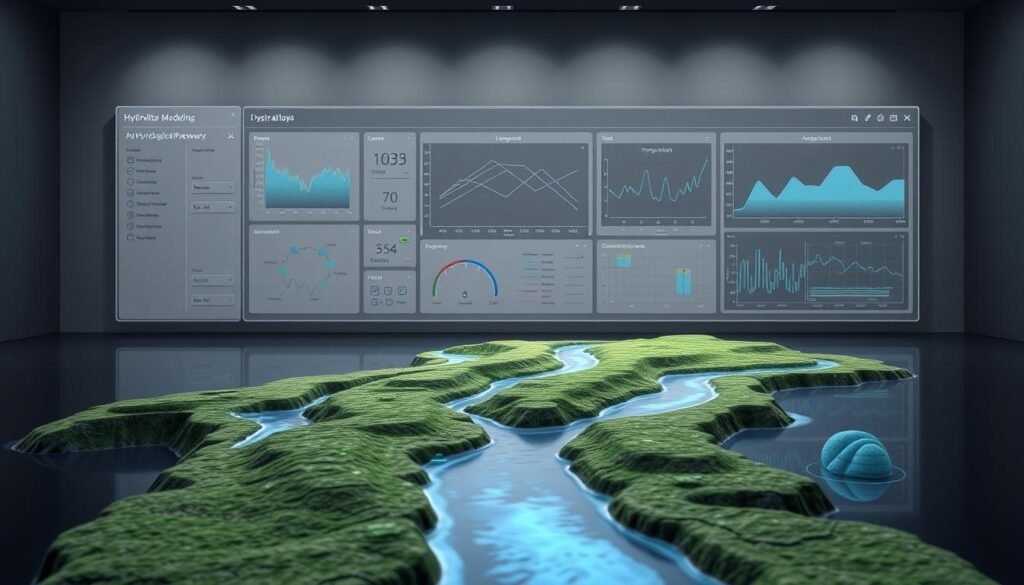
Hydrological Modeling Software
Hydrological modeling software is a crucial tool in hydrological engineering, enabling the simulation of complex water systems. Watershed modeling is a key application, allowing engineers to predict the behavior of watersheds under various conditions, including rainfall events and land-use changes.
These software tools facilitate flood risk assessment by modeling different flood scenarios, thereby aiding in the design of flood mitigation measures. The accuracy of these models depends on the quality of input data, including topographic, soil, and land-use information.
Remote Sensing Techniques
Remote sensing techniques have revolutionized data collection in hydrological engineering. By using satellite or airborne sensors, it’s possible to gather data over large areas, including remote or inaccessible regions. This technology is particularly useful for monitoring changes in land use, vegetation cover, and water bodies.
The integration of remote sensing data with GIS enhances the analysis and interpretation of hydrological data, supporting applications such as watershed management and flood monitoring.
Geographic Information Systems (GIS)
GIS is a powerful tool for hydrological engineers, providing a platform to analyze and visualize spatial data. It is extensively used for watershed delineation, land-use planning, and infrastructure development.
Dr. Padala Raja Shekar’s work on the use of GIS and remote sensing in morphometric analysis highlights the potential of these technologies in understanding hydrological processes. By combining GIS with hydrological modeling, engineers can better assess flood risk and develop more effective mitigation strategies.
Water Resource Management
As the world grapples with water scarcity, the importance of robust water resource management cannot be overstated. Effective management of water resources is crucial for ensuring the sustainability of ecosystems, supporting human consumption, and facilitating economic development.
Sustainable Practices in Water Use
Sustainable water use practices are essential for conserving this vital resource. Techniques such as water recycling, efficient irrigation systems, and reducing water waste can significantly contribute to sustainability. For instance, research at Michigan State University is helping to answer critical questions about water availability and sustainable management, highlighting the importance of adopting sustainable practices in water use.
Integrated Water Resources Management (IWRM)
Integrated Water Resources Management (IWRM) is a holistic approach that considers the social, economic, and environmental aspects of water management. It aims to balance the needs of different stakeholders and ensure that water resources are managed in a way that is equitable, sustainable, and efficient. IWRM involves coordinating across sectors and borders to manage water resources effectively.
For those interested in pursuing a career in this field, programs such as the Hydrology and Water Resources Engineering certificate at NJIT provide comprehensive training in water resources management.
Case Studies from the U.S.
The United States offers several examples of successful water resource management. For instance, the implementation of IWRM principles in the management of the Colorado River Basin has helped to balance the competing demands on this critical water resource. Such case studies provide valuable insights into the challenges and opportunities associated with water resource management.
- Effective water conservation measures
- Innovative technologies for water management
- Collaboration among stakeholders
These elements are crucial for achieving sustainable water resource management and can be applied in various contexts around the world.
Flood Management Strategies
Floods pose significant threats to communities, making robust flood management strategies indispensable. Effective management involves understanding flood risk and implementing measures to mitigate it.
Flood risk assessment is a critical component of flood management. It involves analyzing various factors, including historical flood data, terrain, and environmental conditions.
Floodplain Mapping and Analysis
Floodplain mapping is essential for identifying areas at risk of flooding. By analyzing the terrain and hydrological characteristics, floodplain maps help in planning and decision-making.
Morphometric analysis, for instance, helps predict flood potential by examining slope, drainage density, and basin shape. This information is vital for stormwater management and reducing flood risk.
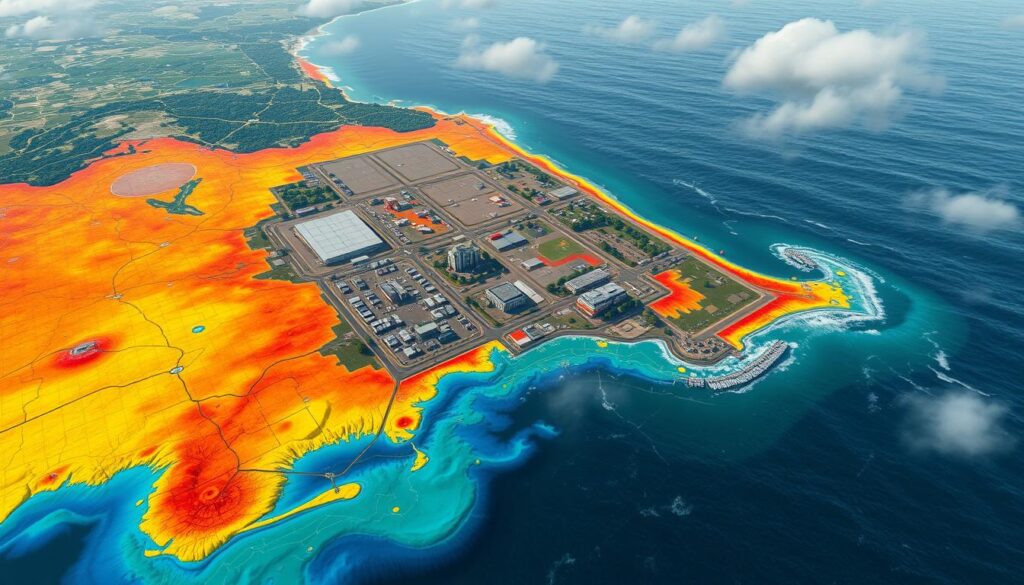
Mitigation Techniques and Technologies
Various techniques and technologies are employed to mitigate flood impacts. These include:
- Implementing flood-control infrastructure such as levees and dams.
- Utilizing advanced hydrological modeling software.
- Employing remote sensing techniques for real-time monitoring.
The following table summarizes some common flood mitigation techniques and their benefits:
| Technique | Benefits |
|---|---|
| Flood-control infrastructure | Protects communities from floodwaters |
| Hydrological modeling | Predicts flood events, aiding in preparedness |
| Remote sensing | Provides real-time data for timely decision-making |
By combining these strategies, communities can significantly reduce the risk and impact of flooding. Effective flood risk assessment and stormwater management are key to successful flood management.
Drought and Water Scarcity
The escalating problem of drought and water scarcity demands innovative solutions and sustainable practices in water resources management. As the global demand for water continues to rise, regions around the world are facing severe droughts, impacting ecosystems, economies, and human societies.
Causes and Effects of Drought
Droughts are primarily caused by a deficiency in precipitation over an extended period, which can be exacerbated by high temperatures and increased evaporation due to climate change. The effects of drought are multifaceted, ranging from reduced water levels in reservoirs and groundwater, to impacts on agriculture, industry, and municipal water supplies. For instance, a study published on Natural Hazards and Earth System Sciences highlights the importance of understanding drought dynamics to mitigate its effects.
The consequences of drought can be severe, including water scarcity, which affects human consumption, agriculture, and ecosystems. Effective management of water resources is crucial to mitigate these impacts.
Innovative Solutions for Water Conservation
Innovative technologies and practices are being developed to address water scarcity. For example, advanced remote sensing techniques and GIS mapping are being used to identify potential groundwater resources, as seen in Saudi Arabia, where researchers are employing such technologies to combat water scarcity. Additionally, implementing sustainable practices such as efficient irrigation systems and water recycling can significantly reduce water waste.
- Implementing water-saving technologies
- Promoting water conservation practices
- Enhancing water storage infrastructure
- Improving water management policies
Moreover, effective project management in civil engineering plays a vital role in developing infrastructure that supports water conservation efforts.
“The key to addressing drought and water scarcity lies in adopting a holistic approach to water resources management, incorporating both traditional knowledge and modern technologies.” – Expert in Water Resources Management
By adopting these strategies, communities can enhance their resilience to drought and ensure a more sustainable future for their water resources.
The Impact of Climate Change
As climate change continues to alter precipitation patterns, the need for adaptive hydrological strategies has never been more critical. Hydrological engineers are at the forefront of developing solutions to mitigate the effects of climate change on water resources.

Changing Precipitation Patterns
Climate change is altering the global water cycle, leading to changes in precipitation patterns. This results in more frequent and severe weather events, such as floods and droughts. Hydrologic modeling plays a crucial role in understanding and predicting these changes, enabling engineers to design more resilient water management systems.
The shift in precipitation patterns also affects the distribution of water resources, impacting both surface water and groundwater. River restoration efforts are essential to maintain healthy aquatic ecosystems and ensure sustainable water use.
Strategies for Adaptation and Resilience
To address the challenges posed by climate change, hydrological engineers are adopting innovative strategies. These include the development of more accurate hydrologic models that can predict future changes in water availability and quality.
Another key strategy is the implementation of Integrated Water Resources Management (IWRM), which promotes a holistic approach to managing water resources. This involves considering the social, economic, and environmental dimensions of water use to achieve sustainable and equitable solutions.
By enhancing resilience in hydrological systems, engineers can help communities adapt to the impacts of climate change. This includes designing infrastructure that can withstand more extreme weather events and implementing practices that conserve water during droughts.
Urban Hydrology
As cities continue to grow, the importance of urban hydrology becomes increasingly evident. Urban hydrology plays a vital role in managing water resources in urban environments, focusing on the challenges posed by stormwater runoff and the implementation of effective management strategies.
Stormwater Management Challenges
Urban areas face unique stormwater management challenges due to the prevalence of impervious surfaces such as roads, buildings, and pavements. These surfaces increase runoff, leading to a higher risk of flooding and water pollution.
Key challenges include:
- Increased runoff due to impervious surfaces
- Pollution from urban activities
- Aging infrastructure
Green Infrastructure Solutions
Green infrastructure offers innovative solutions to the challenges of stormwater management in urban areas. By incorporating natural or semi-natural systems, cities can reduce runoff, improve water quality, and enhance urban ecosystems.
Examples of green infrastructure include:
- Rain gardens
- Permeable pavements
- Green roofs
| Green Infrastructure Type | Benefits | Implementation Cost |
|---|---|---|
| Rain Gardens | Reduces runoff, improves water quality | Moderate |
| Permeable Pavements | Decreases stormwater runoff, enhances groundwater recharge | High |
| Green Roofs | Reduces stormwater runoff, provides insulation | High |
Effective stormwater management through green infrastructure not only mitigates flood risks but also contributes to sustainable urban development.
Agricultural Hydrology
As agriculture continues to be a major consumer of water resources, understanding agricultural hydrology becomes increasingly important. Agricultural hydrology focuses on the interaction between agricultural practices and water resources, highlighting the need for sustainable water management in farming.
Irrigation Techniques and Technology
Irrigation is a critical component of agriculture, especially in areas with limited rainfall. Advances in irrigation techniques and technology have significantly improved water use efficiency. For instance, drip irrigation delivers water directly to the roots of plants, reducing evaporation and runoff.
Efficient irrigation systems not only conserve water but also enhance crop yields. Techniques such as precision irrigation, which uses sensors and data analytics to optimize water application, are becoming more prevalent.
“The adoption of precision irrigation technologies can lead to significant water savings and improved crop productivity.” – Kaleigh Harrison
Impact of Agriculture on Water Resources
Agricultural activities have a profound impact on water resources, affecting both water quantity and quality. Irrigation for agriculture is one of the largest consumers of freshwater globally, and improper irrigation practices can lead to water scarcity and degradation of water quality.
| Impact | Description | Mitigation Strategy |
|---|---|---|
| Water Scarcity | Over-extraction of water for irrigation | Implement water-saving irrigation technologies |
| Water Pollution | Runoff of fertilizers and pesticides | Use integrated pest management and conservation tillage |
| Erosion Control | Soil erosion due to intensive farming | Implement cover cropping and terracing |
Agricultural hydrology helps in understanding these impacts and developing strategies to mitigate them. By adopting sustainable agricultural practices and improving irrigation efficiency, we can protect water resources for future generations.

Hydrology and Ecosystem Balance
Understanding the connection between hydrological processes and ecosystem health is key to preserving natural habitats. Hydrology, the study of water, is fundamental to maintaining the balance of ecosystems. The health of rivers, lakes, and wetlands depends on hydrological processes that regulate water flow, quality, and distribution.
Relationship Between Water and Habitat
The relationship between water and habitat is intricate. Aquatic ecosystems rely on specific hydrological conditions to support a diverse range of plant and animal life. Changes in water flow, temperature, or quality can have significant impacts on these ecosystems. For instance, alterations in river flow can affect the habitats of fish and other aquatic species. As noted by experts, “Morphometric analysis can guide conservation efforts, such as protecting erosion-prone areas,” which is crucial for maintaining ecosystem balance (ecological engineering approaches).
Erosion control measures are essential in preserving habitats. Techniques such as reforestation, terracing, and the use of geotextiles can help stabilize soil and prevent erosion. These methods not only protect existing habitats but also help restore degraded areas.
Restoration Efforts for Aquatic Systems
Restoration efforts for aquatic systems are vital for maintaining ecosystem health. River restoration projects, for example, aim to improve water quality, restore natural flow regimes, and enhance biodiversity. These projects often involve removing barriers, reintroducing native species, and rehabilitating riparian zones.
“Restoring rivers and their floodplains can significantly enhance ecosystem services, including improved water quality, increased biodiversity, and enhanced resilience to climate change.”
Hydrological engineers play a crucial role in these restoration efforts. By applying their knowledge of hydrological processes, they can design and implement effective restoration strategies that ensure the long-term health of aquatic ecosystems.
- Restoration of natural flow regimes
- Improvement of water quality
- Enhancement of biodiversity
By focusing on these key areas, hydrological engineers can help maintain the delicate balance between hydrology and ecosystem health, ensuring the sustainability of our natural resources.
Policy and Regulation in Hydrological Engineering
Policymakers rely on research findings to develop targeted strategies for water conservation and extraction. Effective policy and regulation are crucial for managing water resources sustainably, ensuring that hydrological engineering practices support both human needs and environmental sustainability.
Key Legislation Affecting Water Management
Several key legislative acts have shaped the landscape of water management in the United States. The Clean Water Act and the Safe Drinking Water Act are pivotal in regulating water quality and ensuring that water sources are safe for consumption. These laws mandate the Environmental Protection Agency (EPA) to set standards for water quality and oversee the implementation of these standards by state and local governments.
Another significant piece of legislation is the Flood Control Act, which authorizes the U.S. Army Corps of Engineers to undertake flood control measures, including the construction of dams and levees. This act plays a critical role in managing flood risks and protecting communities from flood-related damages.
| Legislation | Purpose | Impact on Hydrological Engineering |
|---|---|---|
| Clean Water Act | Regulate water quality | Ensures water sources are safe, influencing design and operation of water management infrastructure |
| Safe Drinking Water Act | Ensure safe drinking water | Sets standards for drinking water quality, affecting water treatment processes |
| Flood Control Act | Manage flood risks | Authorizes construction of flood control structures, impacting hydrological systems |
Roles of Government Agencies
Government agencies play a vital role in implementing and enforcing water management policies. The EPA is responsible for setting and enforcing water quality standards. The U.S. Army Corps of Engineers is involved in the design and construction of water management infrastructure, such as dams and levees. Additionally, the U.S. Geological Survey (USGS) conducts research and monitoring of hydrological systems, providing critical data for water resource management.
For more information on hydrologic data collection, visit the ASCE Policy Statement on Hydrologic Data. This resource highlights the importance of accurate and comprehensive data in managing water resources effectively.
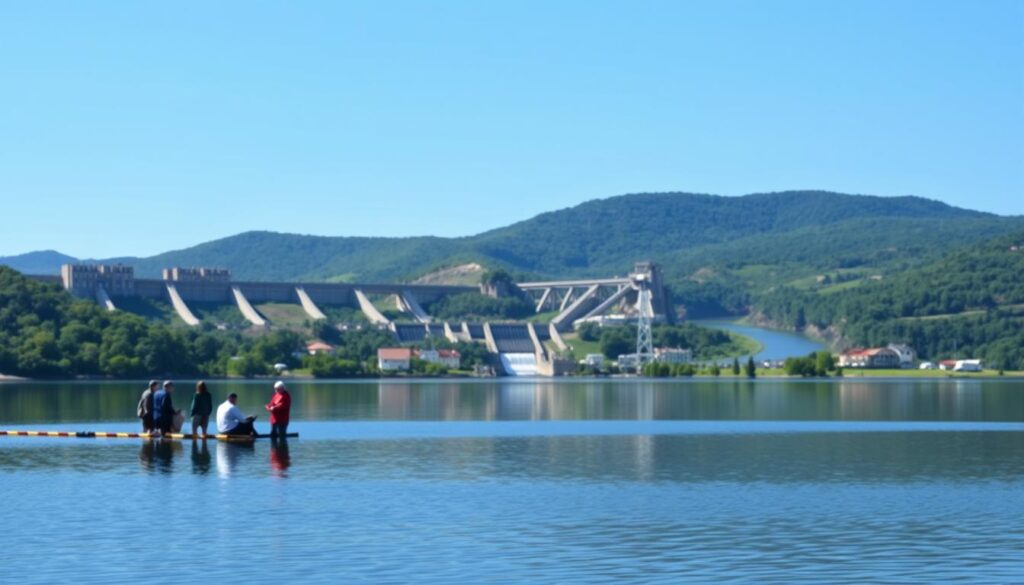
The effective management of water resources requires a coordinated effort among various government agencies, policymakers, and stakeholders. By understanding the policy and regulatory framework governing hydrological engineering, we can better appreciate the complexities involved in managing water resources sustainably.
Education and Research in Hydrology
As the world grapples with water scarcity and flooding, education and research in hydrology play a vital role in finding solutions. The complexity of hydrological systems demands a comprehensive understanding that can only be achieved through robust educational programs and innovative research initiatives.
Academic Programs and Institutions
Several institutions around the world offer specialized programs in hydrological engineering. These programs equip students with the knowledge and skills necessary to tackle real-world water management challenges. For instance, top civil engineering programs often include coursework in hydrology, providing a strong foundation for careers in this field.
Some of the key areas of focus in these academic programs include:
- Hydrologic modeling and watershed analysis
- Water resource management
- Flood risk assessment and mitigation
- Sustainable practices in water use
Current Research Trends and Innovations
Researchers are continually developing new models and techniques to better understand and manage hydrological systems. For example, advancements in hydrologic modeling have enabled more accurate predictions of water flow and flood risks. Similarly, watershed modeling has improved our understanding of how different factors affect water quality and quantity.
Some of the current research trends include:
| Research Area | Description | Innovations |
|---|---|---|
| Hydrologic Modeling | Predicting water flow and flood risks | Advanced computational models |
| Watershed Modeling | Understanding water quality and quantity | Integration of GIS and remote sensing |
| Water Resource Management | Sustainable practices in water use | Decision support systems |
The integration of new technologies, such as geographic information systems (GIS) and remote sensing, has significantly enhanced the field of hydrology. These tools allow for more precise data collection and analysis, leading to better-informed decision-making.
In conclusion, education and research in hydrology are essential for advancing our understanding of water systems and developing effective management strategies. By supporting academic programs and innovative research, we can better address the complex challenges facing our water resources.
Future Trends in Hydrological Engineering
Advancements in technology are set to transform hydrological engineering, enabling more effective and sustainable water resource management. As we move forward, the integration of innovative technologies and methodologies will play a crucial role in shaping the future of this field.
Advances in Water Management Technology
The future of hydrological engineering will be characterized by significant advancements in water management technology. These include the development of more sophisticated hydrological modeling software that can simulate complex water systems with higher accuracy. According to recent trends, such technologies will enhance our ability to predict and manage water-related events, such as floods and droughts.
“The use of advanced technologies in water management is not just a trend; it’s a necessity for ensuring sustainable water resources for future generations,” as noted in a recent study on geohydrological engineering research.

The Role of Data Analytics and AI
Data analytics and Artificial Intelligence (AI) are set to revolutionize hydrological engineering by providing unprecedented insights into water systems. These technologies enable the analysis of vast datasets to identify patterns and predict future trends, thereby improving flood risk assessment and management strategies.
- Enhanced predictive capabilities for flood and drought events
- Improved water resource allocation through data-driven decision-making
- Optimization of hydraulic structures design using AI algorithms
By leveraging these technologies, hydrological engineers can develop more resilient and adaptive water management systems, ultimately contributing to a more sustainable future.
Conclusion: The Future of Water Management
The work of hydrological engineers is crucial for sustainable water resources management, as it addresses the challenges of providing clean and accessible water worldwide.
Hydrological engineering plays a vital role in developing innovative solutions to expand the availability of clean water in regions where it is scarce or contaminated. By leveraging technologies such as desalination, water recycling, and decentralized water treatment, engineers can ensure a resilient future for water resources.
Key Takeaways and Future Directions
The key points discussed in this article highlight the importance of hydrological engineering in water management. As the impacts of climate change and population growth continue to strain the world’s water resources, the need for innovative engineering solutions has never been more urgent.
Embracing Sustainable Practices
To ensure a sustainable future, it is essential to adopt water management practices that prioritize efficiency, conservation, and environmental stewardship. By doing so, we can empower communities to take ownership of their water resources and build a more resilient water management infrastructure.
